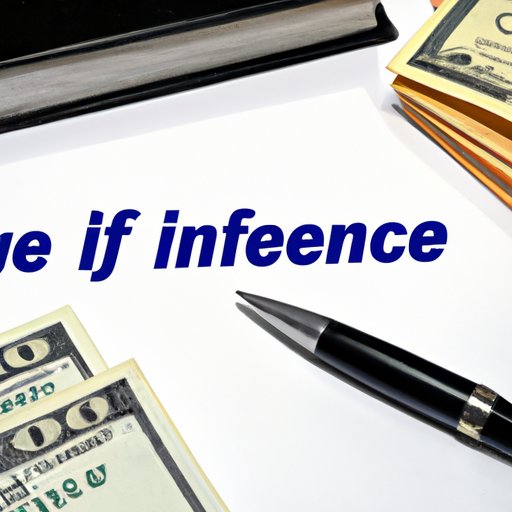
I. Introduction
When looking to borrow money, there are various options available depending on your needs and circumstances. One option is to borrow against the cash value of a life insurance policy. This article aims to explain the basics of life insurance, how to access the cash value, repayment strategies, and tax implications surrounding this option.
II. Basics of Life Insurance
Life insurance is a contract between an individual and the insurance company. The individual makes regular payments to the insurance company in exchange for financial protection in the event of their death. There are two main types of life insurance policies: term and whole life.
Term policies have a set term (such as 10, 20, or 30 years), and only offer a death benefit. Once the term ends, the policy expires and there is no cash value. Whole life policies, on the other hand, are permanent and offer both a death benefit and a cash value. The cash value accumulates over time based on the premiums paid into the policy and can be borrowed against.
When borrowing against the cash value of a life insurance policy, it’s important to understand how the policy works and what the ramifications could be.
III. Determining Cash Value
Cash value is the amount of money available in the policy that can be borrowed against. It is important to understand that cash value is not the same as the face value (the amount paid out upon death). The face value remains the same throughout the life of the policy, while the cash value accumulates along with interest and other benefits.
When determining the cash value of the policy, first check the annual statement provided by the insurance company to determine how much has accumulated. You can also request an in-force illustration if you don’t have the statement. This will give you an estimate of how much cash value you have and how much you can borrow against.
IV. Accessing Cash Value
There are three main options for accessing cash value: taking a loan, taking a partial withdrawal, or surrendering the policy.
When taking a loan, the policyholder borrows against the cash value of the policy. Interest will be charged on the loan, and the policyholder will need to make regular payments to repay the loan. If the policyholder doesn’t make the payments, the outstanding balance will be deducted from the death benefit.
With a partial withdrawal, the policyholder can withdraw a portion of the cash value without having to repay it. However, this will reduce the death benefit and potentially lower the amount of cash value available in the future.
Finally, surrendering the policy means the policyholder cancels the policy and receives the cash value minus any outstanding loans, fees, and surrender charges. This option should be considered very carefully, as it means the death benefit will no longer be available.
When choosing an option, it’s important to consider the pros and cons of each option, and how it will affect the overall policy. For example, taking a loan may have higher interest rates compared to other loan options, and partial withdrawals may result in additional fees and penalties.
V. Repayment of the Loan
When taking a loan, the policyholder must be aware of the repayment terms and conditions set by the insurance company. Interest rates may differ based on the insurance company and the policy’s terms. Interest paid on the loan is typically tax-deductible, making this a more attractive option to some borrowers. The loan must be repaid on a set schedule, and failure to comply can result in a policy lapse or loss of benefits.
There are several ways to make repayments, such as by mail, automatic payments, or paying in person. Depending on the arrangement, loans may continue to accrue interest even while making payments. Therefore, it’s in the borrower’s best interest to pay back the loan as soon as possible.
VI. Tax Implications
Borrowing against a life insurance policy has several tax implications. Interest paid on the loan is typically tax-deductible, which is a significant advantage over other loan options that do not allow the interest to be deductible. However, if the policyholder does not repay the loan, the interest paid will be considered taxable income.
Withdrawals are also subject to taxation, and it’s important to understand the rules surrounding withdrawals. Any withdrawals made up to the amount of total premiums paid into the policy will be tax-free. Any withdrawals made above that amount will be taxed as ordinary income.
It’s also important to consider the impact that borrowing against a life insurance policy will have on the tax status of the policy. If the policy is surrendered or lapses, any outstanding loans will be considered taxable income. To minimize the tax obligations, it’s essential to plan repayment strategies carefully and to consult a tax professional before making any decisions.
VII. Conclusion
Overall, borrowing against a life insurance policy can be a viable option for those in need of funds. However, it’s important to be informed and diligent when considering this option. Understanding the basics of life insurance, determining cash value, accessing cash value, repayment strategies, and tax implications is crucial to make an informed decision. When weighing the benefits against the risks, it’s essential to consult an insurance professional and to make a strategic plan that fits your individual financial needs.





